Overview of Carbide Button Drill Bits
Carbide button drill bits are essential tools in various industries, from mining to construction. They are designed to drill through the hardest materials, offering superior durability and efficiency. This guide dives deep into the world of carbide button drill bits, discussing their types, applications, material properties, compositions, and more. Whether you’re an engineer, a contractor, or simply a DIY enthusiast, this comprehensive guide will provide you with all the information you need.
Types of Carbide Button Drill Bits
Carbide button drill bits come in various types, each designed for specific applications and materials. Here’s a detailed look at some common types:
| Type | Description |
|---|---|
| Spherical Buttons | Ideal for hard and abrasive rock formations, offering high wear resistance and durability. |
| Ballistic Buttons | Designed for fast penetration rates in soft to medium rock formations. |
| Conical Buttons | Suitable for medium to hard rock formations, providing a balance between wear resistance and speed. |
| Parabolic Buttons | Excellent for high-impact applications, providing stability and control. |
| Chisel Buttons | Used for drilling in fractured and jointed rock formations. |
| Flat Top Buttons | Common in general-purpose drilling, offering versatility and durability. |
| Domed Buttons | Ideal for very hard rock formations, providing maximum contact area and durability. |
| Double Dome Buttons | Used in very abrasive rock formations, providing extended tool life. |
| Button Inserts | Replaceable inserts used in various types of drill bits for extended bit life. |
| Tapered Button Bits | Designed for use with tapered drill rods, offering high drilling accuracy. |
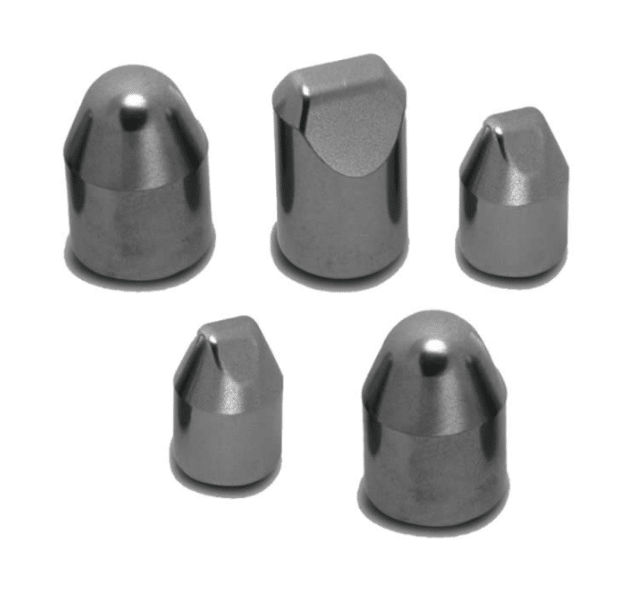
Applications of Carbide Button Drill Bits
Carbide button drill bits are versatile tools used in numerous applications. Here’s a table outlining their primary uses:
| Application | Description |
|---|---|
| Mining | Drilling through hard rock and mineral deposits. |
| Construction | Creating holes in concrete, brick, and other construction materials. |
| Oil and Gas | Drilling through various geological formations for exploration and extraction. |
| Quarrying | Drilling in quarries for the extraction of stone and other materials. |
| Water Well Drilling | Creating boreholes for water extraction. |
| Geothermal Drilling | Drilling for geothermal energy extraction. |
| Tunneling | Excavating tunnels in various rock formations. |
| Blast Hole Drilling | Creating holes for explosives in mining and construction. |
| Foundation Drilling | Drilling for the construction of building foundations and structural supports. |
| Horizontal Directional Drilling | Drilling horizontally for utilities and infrastructure installation. |
Material Properties of Carbide Button Drill Bits
Understanding the material properties of carbide button drill bits is crucial for selecting the right tool for your needs. Here’s a detailed table of the key properties:
| Property | Description |
|---|---|
| Hardness | High hardness for cutting through tough materials. |
| Toughness | Resistance to fracture and chipping. |
| Wear Resistance | Ability to withstand abrasive wear over time. |
| Thermal Stability | Resistance to high temperatures generated during drilling. |
| Chemical Resistance | Resistance to corrosion and chemical attack. |
| Density | High density providing strength and durability. |
| Fracture Toughness | Ability to resist crack propagation. |
| Compressive Strength | High compressive strength to withstand drilling pressures. |
Composition and Characteristics of Carbide Button Drill Bits
The composition of carbide button drill bits greatly influences their performance. Here’s a detailed look at their composition and characteristics:
| Component | Description |
|---|---|
| Tungsten Carbide | Primary component providing hardness and wear resistance. |
| Cobalt Binder | Acts as a binding agent, providing toughness and structural integrity. |
| Titanium Carbide | Added to enhance hardness and thermal stability. |
| Tantalum Carbide | Increases wear resistance and toughness. |
| Niobium Carbide | Enhances the overall strength and durability. |
| Grain Size | Fine grains for higher hardness, coarse grains for greater toughness. |
| Binder Content | Higher binder content for toughness, lower for increased hardness. |
| Additives | Various additives to improve specific properties like thermal resistance or chemical stability. |

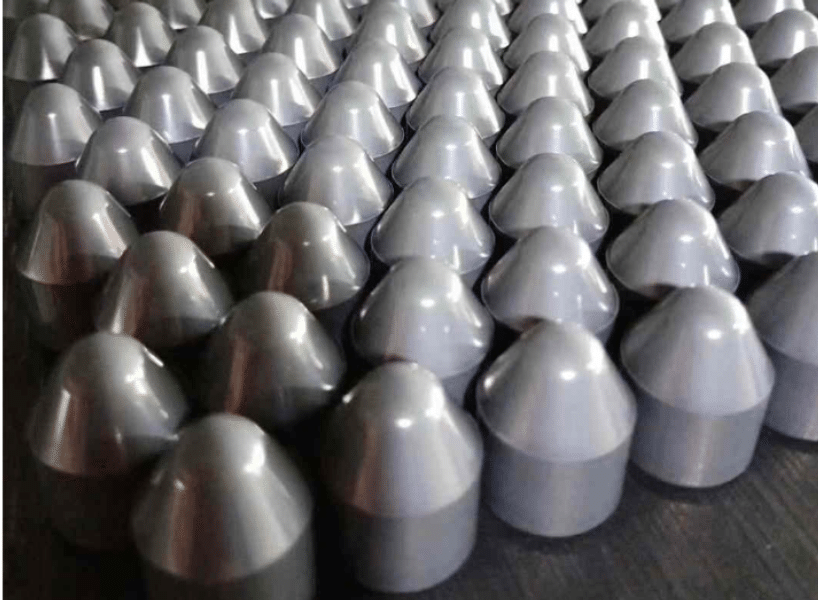
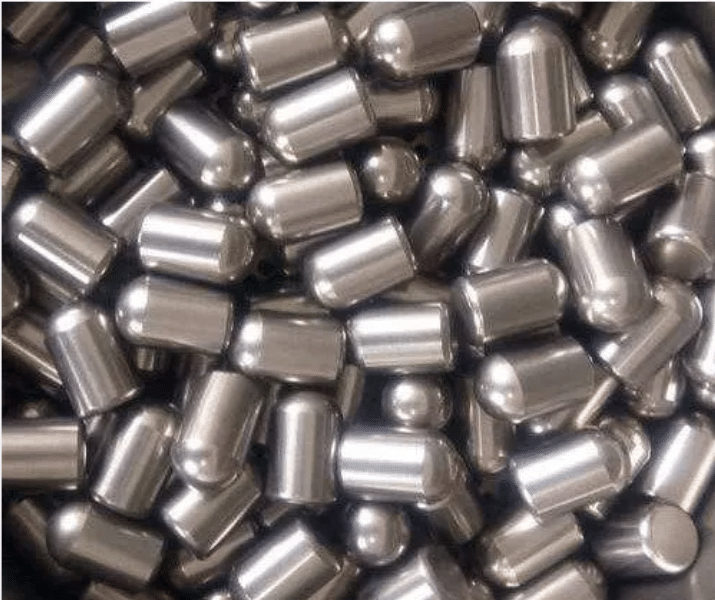
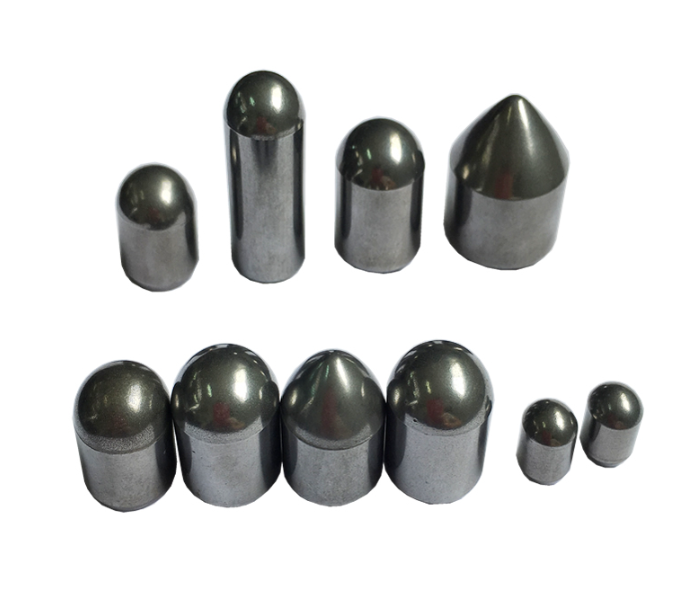
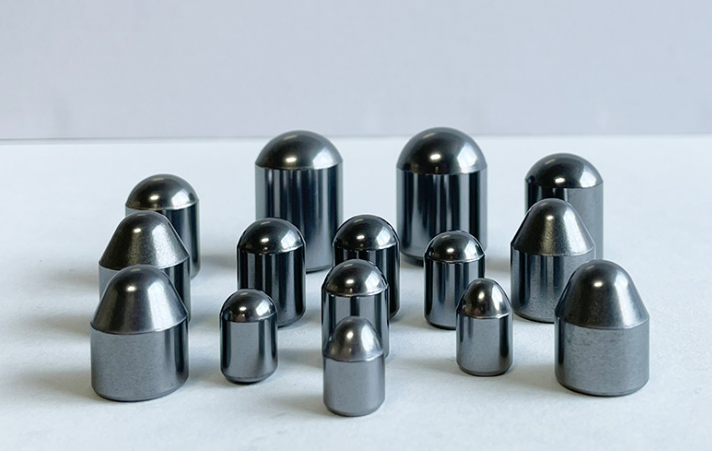
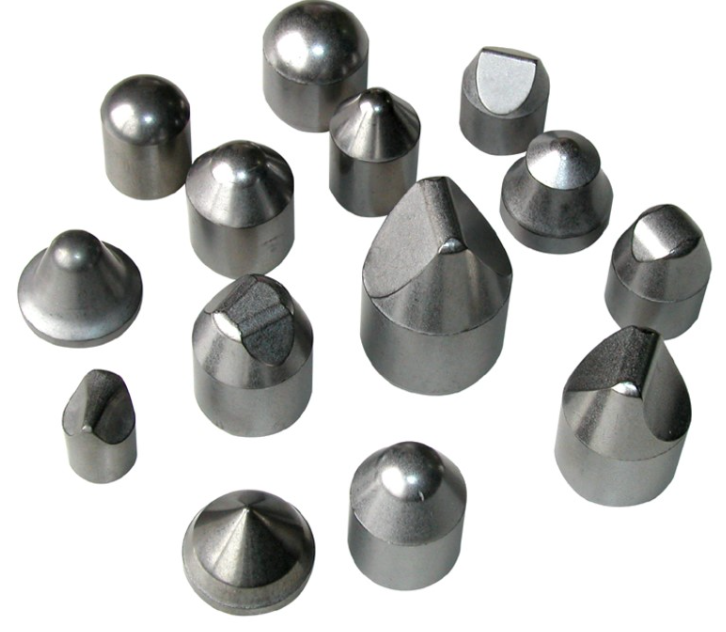
Hardness, Strength, and Wear Resistance of Carbide Button Drill Bits
The performance of carbide button drill bits is often measured by their hardness, strength, and wear resistance. Here’s how these properties compare:
| Property | Measurement | Description |
|---|---|---|
| Hardness (HV) | 1500 – 2200 | High hardness ensures efficient cutting and drilling. |
| Transverse Rupture Strength (MPa) | 3000 – 4500 | Measures the bending strength, indicating toughness. |
| Compressive Strength (MPa) | 4000 – 6000 | High compressive strength for withstanding drilling pressures. |
| Fracture Toughness (MPa√m) | 9 – 15 | Indicates resistance to crack propagation. |
| Wear Resistance (mg) | 0.1 – 0.5 | Low wear rates ensure long-lasting performance. |
Specifications, Sizes, Shapes, and Standards of Carbide Button Drill Bits
Carbide button drill bits come in various specifications to meet different drilling needs. Here’s a table summarizing these specifications:
| Specification | Description |
|---|---|
| Diameter Range | 20mm – 152mm |
| Length Range | 50mm – 500mm |
| Button Shape | Spherical, Conical, Ballistic, Chisel, Flat Top, Domed, Double Dome |
| Shank Type | Tapered, Threaded, Hexagonal |
| Standards | ISO, ANSI, DIN, API |
Suppliers and Pricing Details of Carbide Button Drill Bits
Finding the right supplier is crucial for ensuring quality and cost-efficiency. Here’s a list of some well-known suppliers along with their pricing details:
| Supplier | Location | Price Range | Website |
|---|---|---|---|
| Kennametal | USA | $30 – $300 | kennametal.com |
| Sandvik | Sweden | $40 – $350 | home.sandvik |
| Element Six | UK | $50 – $400 | e6.com |
| Seco Tools | Sweden | $35 – $330 | secotools.com |
| Atlas Copco | Sweden | $45 – $375 | atlascopco.com |
| Carbide Depot | USA | $25 – $320 | carbidedepot.com |
| China Tungsten Online | China | $20 – $300 | chinatungsten.com |
| Hyperion Materials & Technologies | USA | $30 – $350 | hyperionmt.com |
| Zhuzhou Cemented Carbide Group | China | $25 – $280 | zzcarbide.com |
| Guhring | Germany | $40 – $340 | guhring.com |
How to Select the Right Carbide Button Drill Bit
Choosing the right carbide button drill bit involves several considerations. Here’s a detailed guide to help you make the right choice:
| Consideration | Description |
|---|---|
| Material to be Drilled | Different materials require specific types of drill bits. |
| Rock Formation | Hardness and abrasiveness of the rock affect bit selection. |
| Drilling Conditions | Wet or dry conditions can influence bit performance. |
| Penetration Rate | Desired drilling speed and efficiency. |
| Bit Size and Shape | Size and shape should match the drilling equipment and application. |
| Cost | Balancing budget with performance requirements. |
| Supplier Reputation | Quality and reliability of the supplier. |
| Technical Support | Availability of technical support and services. |
Comparing Advantages and Limitations of Carbide Button Drill Bits
Every tool has its pros and cons. Here’s a comparative look at the advantages and limitations of carbide button drill bits:
| Aspect | Advantages | Limitations |
|---|---|---|
| Durability | Long-lasting performance in tough conditions. | Higher initial cost compared to other types. |
| Drilling Efficiency | High penetration rates in various materials. | May require specialized equipment and handling. |
| Versatility | Suitable for a wide range of applications and materials. | Not always the best choice for very soft materials. |
| Wear Resistance | Excellent wear resistance, reducing downtime for replacements. | Can be brittle under extreme impact or improper use. |
| Thermal Stability | Performs well under high temperatures. | Thermal stability can vary based on the composition and grade. |
| Cost-effectiveness | Longer tool life reduces overall cost. | Initial investment can be high for high-quality bits. |
Specific Metal Powder Models for Carbide Button Drill Bits
Carbide button drill bits are manufactured using various metal powder models. Here are some specific models with their descriptions:
| Metal Powder Model | Description |
|---|---|
| WC-Co (Tungsten Carbide-Cobalt) | The most common model, offering a good balance of hardness and toughness. |
| WC-TiC-Co (Tungsten Carbide-Titanium Carbide-Cobalt) | Enhanced wear resistance and thermal stability. |
| WC-TaC-Co (Tungsten Carbide-Tantalum Carbide-Cobalt) | Improved toughness and fracture resistance. |
| WC-NbC-Co (Tungsten Carbide-Niobium Carbide-Cobalt) | High strength and durability, suitable for very hard materials. |
| WC-Co-Cr (Tungsten Carbide-Cobalt-Chromium) | Superior corrosion resistance and wear properties. |
| WC-Ni (Tungsten Carbide-Nickel) | High hardness and toughness with excellent chemical resistance. |
| WC-Co-Mo (Tungsten Carbide-Cobalt-Molybdenum) | Balanced hardness and toughness with improved wear resistance. |
| WC-Co-V (Tungsten Carbide-Cobalt-Vanadium) | Enhanced performance in high-temperature applications. |
| WC-Co-Ta (Tungsten Carbide-Cobalt-Tantalum) | Increased strength and fracture toughness. |
| WC-Co-Fe (Tungsten Carbide-Cobalt-Iron) | High impact resistance and durability. |
Function of Carbide Button Drill Bits
Carbide button drill bits serve a critical function in drilling applications. Here’s a detailed look at their functions:
| Function | Description |
|---|---|
| Cutting | Efficiently cutting through hard and abrasive materials. |
| Penetration | Achieving high penetration rates in various rock formations. |
| Stability | Providing stability and control during drilling operations. |
| Wear Resistance | Withstanding abrasive wear and extending tool life. |
| Heat Dissipation | Efficiently dissipating heat generated during drilling. |
| Impact Resistance | Withstanding high-impact forces during drilling. |
| Versatility | Suitable for a wide range of drilling applications and materials. |
| Precision | Offering precise drilling with minimal deviation. |

FAQ
Here’s a handy FAQ section to answer some common questions about carbide button drill bits:
| Question | Answer |
|---|---|
| What are carbide button drill bits used for? | They are used for drilling through hard and abrasive materials in various industries. |
| How do I choose the right carbide button drill bit? | Consider the material to be drilled, drilling conditions, and desired penetration rate. |
| What makes carbide button drill bits durable? | Their high hardness, wear resistance, and thermal stability contribute to their durability. |
| Can carbide button drill bits be used in wet conditions? | Yes, they perform well in both wet and dry conditions. |
| How do I maintain carbide button drill bits? | Regular inspection, proper handling, and using appropriate drilling techniques help maintain them. |
| Where can I buy carbide button drill bits? | They can be purchased from various suppliers such as Kennametal, Sandvik, and others listed above. |
| Are carbide button drill bits cost-effective? | Despite the higher initial cost, their long tool life makes them cost-effective in the long run. |
| What are the limitations of carbide button drill bits? | They can be brittle under extreme impact and may require specialized equipment. |
| Can they be used for all materials? | While versatile, they are not always the best choice for very soft materials. |
| What sizes do carbide button drill bits come in? | They are available in various sizes ranging from 20mm to 152mm in diameter. |
Conclusion
Carbide button drill bits are invaluable tools for drilling through the toughest materials. By understanding their types, applications, material properties, and how to select the right one, you can make informed decisions that enhance your drilling operations. This guide has provided a comprehensive overview, complete with detailed tables and FAQs, ensuring you have all the information you need at your fingertips. Whether you’re in mining, construction, or any other industry requiring efficient drilling, carbide button drill bits offer the performance and reliability you need.




